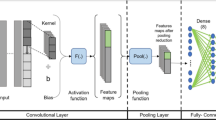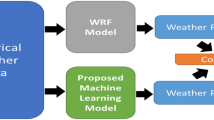Abstract
For the regulation and operation of electrical systems, a reliable and precise prediction of solar irradiation is extremely beneficial. Therefore, this paper deals with the issue of accurate and reliable estimation of solar irradiance by developing and investigating the different standalone and hybrid forecasting models. Eleven different models: Feedforward neural network (FFNN), long short term memory (LSTM), gated recurrent unit (GRU), Bidirectional long short term memory (BDLSTM), BDLSTM with empirical mode decomposition (EMD), ensemble empirical mode decomposition (EEMD), complete ensemble empirical mode decomposition with adaptive noise (CEEMDAN), variational mode decomposition (VMD), wavelet transform (WT) and wavelet packet decomposition (WPD) are developed for point and interval forecasting of solar global horizontal irradiance (GHI) on hour ahead basis for two Indian locations. The autocorrelation function ((ACF) and partial autocorrelation function (PACF) are used as statistical measurement to select the optimal lags of the input lags of deep learning (DL) predictors. Likewise, the grid search algorithm is used to select the optimum value of hyperparameters of the predictor. To evaluate the model’s performance, root mean square error (RMSE) and mean absolute error (MAE) for point forecast whereas; prediction interval nominal confidence (PINC), average coverage error (ACE) and prediction interval average width (PIAW) for the interval forecast are calculate for annual and seasonal datasets. From the study, the WPD based model achieved the minimum annual RMSE (11.35 W/m2 & 10.49 W/m2) and MAE (6.04 W/m2 & 6.41W/m2). Likewise, at confidence interval (CI) = 99%, the PICP, ACE and PIAW achieved by WPD are ranges from 80.66–81.27, 19.92–21.03, 17.71–18.33 respectively.









Similar content being viewed by others
Data availability
The data that support the findings of this study are available from the corresponding author upon reasonable request.
Code availability
The codes of this study are available from the corresponding author upon reasonable request.
References
Abdel-Nasser M, Mahmoud K, Lehtonen M (2021) Reliable solar irradiance forecasting approach based on choquet integral and Deep LSTMs. IEEE Trans Industr Inform 17(3):1873–1881. https://doi.org/10.1109/TII.2020.2996235
Acikgoz H (2022) A novel approach based on integration of convolutional neural networks and deep feature selection for short-term solar radiation forecasting. Appl Energy 305:117912.https://doi.org/10.1016/J.APENERGY.2021.117912
Ali M, Prasad R, Xiang Y et al (2021) Variational mode decomposition based random forest model for solar radiation forecasting: New emerging machine learning technology. Energy Rep 7:6700–6717. https://doi.org/10.1016/J.EGYR.2021.09.113
Benali L, Notton G, Fouilloy A, Voyant C, Dizene R (2019) Solar radiation forecasting using artificial neural network and random forest methods: Application to normal beam, horizontal diffuse and global components. Renew Energy 132:871–884. https://doi.org/10.1016/j.renene.2018.08.044
Bouzgou H, Gueymard CA (2019) Fast short-term global solar irradiance forecasting with wrapper mutual information. Renew Energy 133:1055–1065. https://doi.org/10.1016/j.renene.2018.10.096
Chen Q, Chen Y, Bai X (2020) Deterministic and Interval Wind Speed Prediction Method in Offshore Wind Farm Considering the Randomness of Wind. Energies 13(21):5595. https://doi.org/10.3390/EN13215595
Fischer T, Krauss C (2018) Deep learning with long short-term memory networks for financial market predictions. Eur J Oper Res 270(2):654–669. https://doi.org/10.1016/j.ejor.2017.11.054
Gao B, Huang X, Shi J, Tai Y, Xiao R (2019) Predicting day-ahead solar irradiance through gated recurrent unit using weather forecasting data. Journal of Renewable and Sustainable Energy 11(4):043705. https://doi.org/10.1063/1.5110223
Gao B, Huang X, Shi J, Tai Y, Zhang J (2020) Hourly forecasting of solar irradiance based on CEEMDAN and multi-strategy CNN-LSTM neural networks. Renew Energy 162:1665–1683. https://doi.org/10.1016/j.renene.2020.09.141
Gamarro H, Gonzalez JE, Ortiz LE (2019) On the assessment of a numerical weather prediction model for solar photovoltaic power forecasts in cities. Journal of Energy Resources Technology, Transactions of the ASME 141(6).https://doi.org/10.1115/1.4042972
Huang X, Li Q, Chen Z et al (2021) Hybrid deep neural model for hourly solar irradiance forecasting. Renew Energy 171:1041–1060. https://doi.org/10.1016/j.renene.2021.02.161
Jahani B, Mohammadi B (2019) A comparison between the application of empirical and ANN methods for estimation of daily global solar radiation in Iran. Theor Appl Climatol 137(1–2):1257–1269. https://doi.org/10.1007/s00704-018-2666-3
Kumari P, Toshniwal D (2021) Extreme gradient boosting and deep neural network-based ensemble learning approach to forecast hourly solar irradiance.J Clean Prod279:123285.https://doi.org/10.1016/j.jclepro.2020.123285
Li C, Tang G, Xue X, Chen X, Wang R, Zhang C (2020) The short-term interval prediction of wind power using the deep learning model with gradient descend optimization. Renew Energy 155:197–211. https://doi.org/10.1016/j.renene.2020.03.098
Makade RG, Chakrabarti S, Jamil B (2021) Development of global solar radiation models: A comprehensive review and statistical analysis for Indian regions. J Clean Prod293:126208.https://doi.org/10.1016/J.JCLEPRO.2021.126208
Massaoudi M, Chihi I, Sidhom L et al (2021) An Effective Hybrid NARX-LSTM Model for Point and Interval PV Power Forecasting. IEEE Access 9:36571–36588. https://doi.org/10.1109/ACCESS.2021.3062776
Mejia JF, Giordano M, Wilcox E (2018) Conditional summertime day-ahead solar irradiance forecast. Sol Energy 163:610–622. https://doi.org/10.1016/j.solener.2018.01.094
Netsanet S, Zheng D, Zhang W, Teshager G (2022) Short-term PV power forecasting using variational mode decomposition integrated with Ant colony optimization and neural network. Energy Rep 8:2022–2035. https://doi.org/10.1016/J.EGYR.2022.01.120
Niu D, Sun L, Yu M, Wang K (2022) Point and interval forecasting of ultra-short-term wind power based on a data-driven method and hybrid deep learning model. Energy, 254:124384.https://doi.org/10.1016/J.ENERGY.2022.124384
Ofori-Ntow Jnr E, Ziggah YY, Relvas S (2021) Hybrid ensemble intelligent model based on wavelet transform, swarm intelligence and artificial neural network for electricity demand forecasting. Sustain Cities Soc 66:102679.https://doi.org/10.1016/J.SCS.2020.102679.
Peng T, Zhang C, Zhou J, Nazir MS (2021) An integrated framework of Bi-directional long-short term memory (BiLSTM) based on sine cosine algorithm for hourly solar radiation forecasting.Energy 221:119887.https://doi.org/10.1016/j.energy.2021.119887
Qing X, Niu Y (2018) Hourly day-ahead solar irradiance prediction using weather forecasts by LSTM. Energy 148:461–468. https://doi.org/10.1016/j.energy.2018.01.177
Sahu RK, Shaw B, Nayak JR, Shashikant (2021) Short/medium term solar power forecasting of Chhattisgarh state of India using modified TLBO optimized ELM.Engineering Science and Technology, an International Journal https://doi.org/10.1016/J.JESTCH.2021.02.016
Saroha S, Zurek-Mortka M, Szymanski JR, Shekher V, Singla P (2021) Forecasting of Market Clearing Volume Using Wavelet Packet-Based Neural Networks with Tracking Signals. Energies 14(19):6065. https://doi.org/10.3390/EN14196065
Singla P, Duhan M, Saroha S (2021a) A comprehensive review and analysis of solar forecasting techniques. Frontiers in Energy 1–37.https://doi.org/10.1007/s11708-021-0722-7
Singla P, Duhan M, Saroha S (2021b) An ensemble method to forecast 24-h ahead solar irradiance using wavelet decomposition and BiLSTM deep learning network.Earth Science Informatics 1:1–16.https://doi.org/10.1007/S12145-021-00723-1
Singla P, Duhan M, Saroha S (2021c) Review of Different Error Metrics: A Case of Solar Forecasting. AIUB Journal of Science and Engineering (AJSE) 20(4):158–165. https://doi.org/10.53799/AJSE.V20I4.212
Singla P, Duhan M, Saroha S (2022a) Solar irradiation forecasting by long-short term memory using different training algorithms 81–89.https://doi.org/10.1007/978-981-16-4663-8_7
Singla P, Duhan M, Saroha S (2022b) A Hybrid Solar Irradiance Forecasting Using Full Wavelet Packet Decomposition and Bi-Directional Long Short-Term Memory (BiLSTM). Arab J Sci Eng, 1–27. https://doi.org/10.1007/S13369-022-06655-2/TABLES/18
Wang S, Sun Y, Zhou Y, Mahfoud RJ, Hou D (2020) A New Hybrid Short-Term Interval Forecasting of PV Output Power Based on EEMD-SE-RVM. Energies 13(1):87. https://doi.org/10.3390/EN13010087
Wang H, Xue W, Liu Y, Peng J, Jiang H (2020a) Probabilistic wind power forecasting based on spiking neural network.Energy 196: 117072.https://doi.org/10.1016/J.ENERGY.2020.117072
Yadav HK, Pal Y, Tripathi MM (2020) Short-term PV power forecasting using empirical mode decomposition in integration with back-propagation neural network. 41(1):25–37.https://doi.org/10.1080/02522667.2020.1714181
Funding
This research is not supported by any funding agency.
Author information
Authors and Affiliations
Contributions
All authors contributed to the study conception and design. Material preparation, data collection, and analysis were performed by Dr. Pardeep Singla, Dr. Manoj Duhan, and Dr. Sumit Saroha. The first draft of the manuscript was written by Dr. Pardeep Singla. All authors read and approved the final manuscript.
Corresponding author
Ethics declarations
Competing interests
The authors declare no competing interests.
Additional information
Communicated by H. Babaie.
Publisher's note
Springer Nature remains neutral with regard to jurisdictional claims in published maps and institutional affiliations.
Rights and permissions
Springer Nature or its licensor (e.g. a society or other partner) holds exclusive rights to this article under a publishing agreement with the author(s) or other rightsholder(s); author self-archiving of the accepted manuscript version of this article is solely governed by the terms of such publishing agreement and applicable law.
About this article
Cite this article
Singla, P., Duhan, M. & Saroha, S. A point and interval forecasting of solar irradiance using different decomposition based hybrid models. Earth Sci Inform 16, 2223–2240 (2023). https://doi.org/10.1007/s12145-023-01020-9
Received:
Accepted:
Published:
Issue Date:
DOI: https://doi.org/10.1007/s12145-023-01020-9




